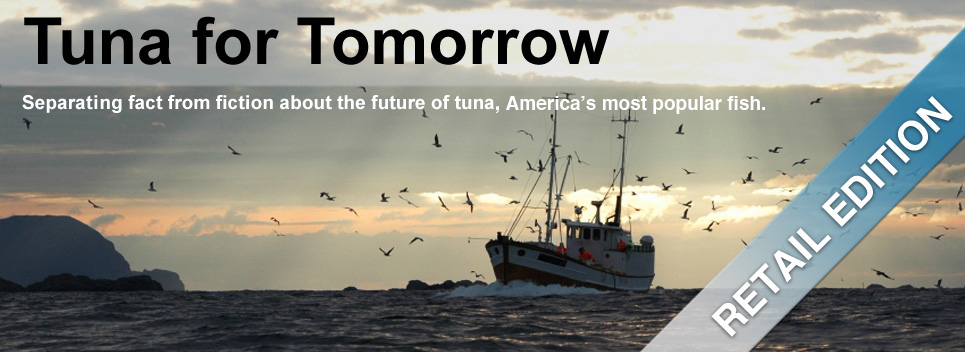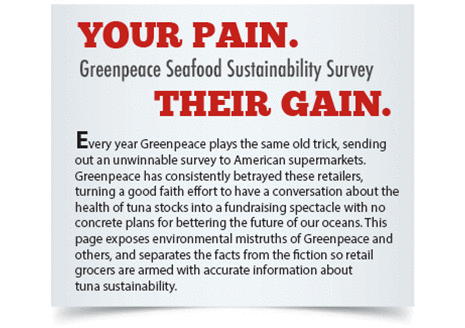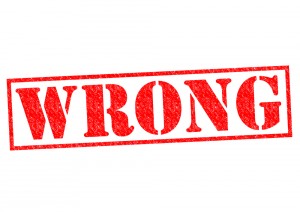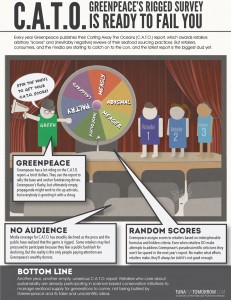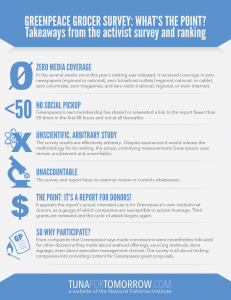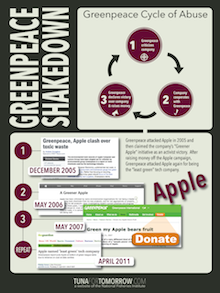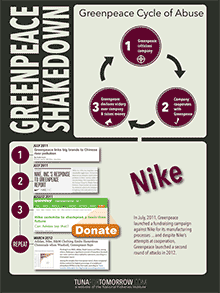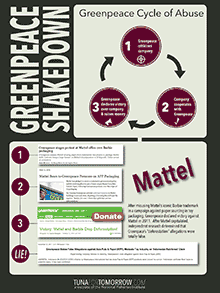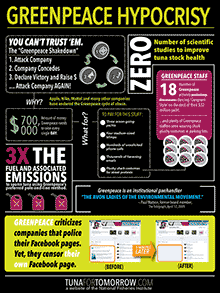Greenpeace’s Focus on Fundraising
It’s that time of year again – time for Greenpeace to ramp up their end-of-year fundraising efforts. The annual rank’n’spank from Greenpeace is once again focused on bringing in donations by disparaging foodservice providers. Their annual, arbitrary ranking of seafood sustainability first targeted brands; a few years later, they switched to retailers. Last year, Greenpeace moved on to foodservice suppliers. This year’s Sea of Distress report continues the trend of using subjective and hidden scoring methodology in an attempt to pit companies against each other all in an effort to drive Greenpeace fundraising efforts.
Science, Maybe You’ve Heard of It
Unfortunately, Greenpeace is so preoccupied with these money-making schemes that it’s failed to stay up-to-date on the latest scientific research. This has put them in the embarrassing position of criticizing seafood companies for using ecologically superior fishing methods. Their latest report recommends only using tuna caught by “pole and line, troll, handline, or FAD-free catch methods.” Yet a University of California study found that these methods are extremely carbon intensive, consuming approximately three to four times more fuel than boats using more efficient methods. As a result of their failure to do the most elementary scientific inquiry, Greenpeace activists find themselves in the awkward position of advocating for increased pollution as a means of preserving tuna stocks, even at a time when scientists say global tuna stocks are healthy.
Greenpeace’s Nutritional Nonsense
More egregiously, Greenpeace goes as far as telling consumers to “eat less seafood.” Not content to simply peddle bad science, Greenpeace is now promoting bad nutrition advice. Their campaign against seafood comes at a time when nutritionists agree that Americans need to eat more seafood, not less. The Dietary Guidelines for Americans urge consumers to eat more fish. Studies have found that insufficient seafood consumption is to blame for nearly 84,000 preventable deaths each year, and that seafood is an essential part of brain and eye development in children. Yet Greenpeace ignores reams of unbiased, peer reviewed scientific research attesting to the importance of seafood, instead contributing to American health woes by offering reckless nutrition advice.
Attention Greenpeace Donors
Donors to Greenpeace should note their money is being wasted and these reports fail to address real sustainability efforts. Instead, Greenpeace will continue to lose millions in donor money bet on financial speculation, desecrate sacred places, and dress up in animal costumes to make music videos. Since Greenpeace refuses to do actual research on seafood sustainability or take a seat at the table where real sustainability efforts are discussed, they’re reduced to rehashing the same old campaign. The question is, why do donors keep falling for the same, washed-up tactics?
Foodservice dedicated to sustainability
Foodservice companies are dedicated to supply chain sustainability. The seafood community on so many levels has worked with scientists, ocean experts, industry leaders, and fisheries champions to craft effective, enforceable, and verifiable sustainability practices. Having Greenpeace chime in once a year to say these groups don’t do enough is absurd. Instead of wasting money on a fundraiser with terrible nutritional advice, perhaps Greenpeace should invest in actual research, hire scientists, and join in on meaningful sustainability discussions.

Another Greenpeace publicity scheme prepares to end in failure and embarrassment. For the last several years, the global fundraising group had tried to create buzz for a makeshift top-ten list of sorts — ranking grocery retailers on seafood sourcing practices.
At first, it got a little coverage from their friends in the activist media. But after NFI alerted editors to some obvious problems in the methodology, media attention fell off a cliff. What sort of problems? First, the “survey” Greenpeace used with the retailers (read: the targets) was completely arbitrary and the underlying measurements hidden from view. Or to put it in journalism terms: fabricated. Second, those companies that responded in good faith to the survey were actually singled out for further abuse and hostility from Greenpeace.
Turns out that asking reporters to deceive readers and squandering donor money for zero results isn’t a very smart strategy.
So what did the geniuses at Greenpeace do next? They decided to use the exact same trick, but this time to go after foodservice companies, hoping for a different result. Greenpeace’s attempts to strong-arm retailers into agreeing with their unsubstantiated views on sustainability were an abject failure – and was finally scrapped after retailers realized the futility of responding to Greenpeace only brought on more attacks. Retailers began sitting quietly until the fundraising stunt was over – refusing to be part of the cycle of abuse. There was simply no upside to negotiating with activists who are happy to rake companies over the coals whether they cooperate or not.
Meanwhile, Greenpeace is so busy with arbitrary rankings that they’ve never done a single environmental or economic impact study of the fishing methods they say they prefer. Methods, like pole and line fishing, which would require vastly more boats and greater fuel consumption. The tuna industry, on the other hand, has worked for years with scientists and ocean experts, industry leaders, and fisheries champions to craft effective, enforceable, and verifiable sustainability practices – which is why bycatch rates are at historic lows.
But it’s been more than 1880 days since they were invited by the International Seafood Sustainability Foundation (ISSF) to participate in the ongoing dialogue about tuna fisheries and sustainability. Greenpeace refuses to join the grown-ups at the table to discuss real sustainability studies. This would clearly take too much time away from hitting donors up for cash.
Donors should take note of their failure to work seriously on sustainability issues and the myriad of legal, ethical, financial and reputational problems facing Greenpeace around the globe – from losing millions in donor money on financial speculation, to criminally desecrating the Nazca Lines, to facing an ongoing federal racketeering and fraud lawsuit. Can Greenpeace explain why foodservice companies should risk their professional reputation to work with them?
Greenpeace, after all, proudly states that it has “no permanent friends.” Which means that one capitulation is never enough. Greenpeace claims a victory, and fundraises off each win, but they inevitably come back—after a few months, or a few years—with a new round of attacks, demands and even standards.
Luckily, the example of Greenpeace’s failed retailer rank’n’spank is out there for all to see. The cost of “cooperating” far exceeds that of ignoring them all together, especially considering that traditional and social media coverage of their retailer-focused attacks diminished to the point of non-existence. Quite simply, Greenpeace is a one-trick pony.

If you go to the Greenpeace page announcing their latest assault on a company—this time it’s Wal-Mart and its seafood sourcing policy—the very first thing you’ll see is “DONATE” and “GIVE TO GREENPEACE” splashed across the top of the page. It’s what they’re about. The sun rises in the east, it sets in the west, and Greenpeace shakes down companies to juice fundraising. The targets change, but the tactics have remained the same for years.
With Greenpeace that means a particularly vicious cycle: Assault a company with spurious charges, secure concessions in exchange for a promise to halt the attack, fundraise off this “victory”, rinse, repeat. As too many companies have learned the hard way, Greenpeace has, in its own words, has “no permanent friends.” More fitting, perhaps, would be to quote Arnold Schwarzenegger: With Greenpeace it’s always “We’ll be back.”
As ever when it comes to canned tuna, Greenpeace’s feigned concern is alleged excessive “bycatch” as a result of the use of Fish Aggregating Devices (FADs)—small, harmless free floating rafts or buoys used to attract fish. But Greenpeace provides no scientific data to back up this claim, because there isn’t any. Indeed, the best peer-reviewed science finds FADs have bycatch rates similar to, or less than, other fishing methods, and don’t have a significant impact on threatened marine species.
What FADs are connected with is greater efficiency, lower fuel costs, and a smaller carbon footprint for the industry.
So why does Greenpeace brag about hunting down and vandalizing these devices with a fleet of speedboats, helicopters, drones, remote controlled submarines, and a gas-guzzling former Soviet naval vessel?
Could it be to distract attention from the fact that they’ve never done a single environmental or economic impact study of the fishing methods they say they prefer? Methods that would require vastly more boats and greater fuel consumption?
The tuna industry has worked for years with scientists and ocean experts, industry leaders, and fisheries champions to craft effective, enforceable, and verifiable sustainability practices – which is why bycatch rates are at historic lows. Greenpeace, meanwhile, refuses to join the grown-ups at the table.
It might take time away from hitting donors up for cash.

Overused and ineffective rank’n’spank system makes another appearance
March 9 2014 – WASHINGTON, DC – Greenpeace has released a new fund raising campaign designed to rank U.S. canned tuna companies and solicit donations from supporters. The list itself follows the model Greenpeace has used for years: rank companies based on a system for which the scoring methodology is totally arbitrary and hidden, then promote those rankings in the media—rank’n’spank.
The non-scientific, non-transparent and completely subjective rankings are one of the thinnest offerings Greenpeace has ever promoted. While other annual rank’n’spank campaigns have been largely dismissed as ineffective sideshows, with a target audience of donors and institutional supporters Greenpeace has at least made an effort to make those operations appear robust. This latest promotion is anemic at best.
The media should keep in mind that Greenpeace is the same group that refuses to join the International Seafood Sustainability Foundation (ISSF)’s ongoing dialogue about tuna.
sustainability. The Foundation, a partnership between global tuna canners (including Bumble Bee, Chicken of the Sea and Starkist), scientists and WWF, is the premier tuna conservation group. Reporters and producers might find it odd that Greenpeace doesn’t even acknowledge a group whose mission is to undertake science-based initiatives for the long-term conservation and sustainable use of tuna stocks yet they will rank companies who participate in such group.
The media is advised to research Greenpeace’s strategy and push for scrutiny on its unpublished methodology. Further it’s urged to recognize the timing of Greenpeace’s fundraising pitches and the release of such rankings. When you click to “add your name” to what appears to be an online petition, notice two things 1.) Only the three top branded tuna companies are addressed in the “petition” despite ranking fourteen 2.) You are required to give them your name and email address to sign on – we encourage reporters to test this system and watch your inbox begin to fill up with donation requests almost right away.
Greenpeace is a multinational behemoth with a $300-million a year operating budget. It has spent a grand total of zero dollars on tuna science, yet continues to use tuna as a poster child for its fund raising efforts.
###


Greenpeace relies on major donations from distinguished foundations like Tides and Packard, groups that use florid language to set forth high-minded goals. But Greenpeace’s unserious and self-indulgent actions rarely live up to their sponsors’ idealistic rhetoric. Tides was founded by philanthropist Drummond Pike…

Click here for a full size version.

Before you fill out Greenpeace’s seafood sustainability survey, it’s important to remember what this activist group is really all about.
While you’re working hard to buy seafood certified by third-party auditors, participate in fishery improvement projects and incorporate best practices into your policies, Greenpeace activists are dressing up in silly costumes to garner publicity and more donations.
Of course, their commitment to organizing meaningless stunts and harassing tuna companies leaves them no time to master the science behind sustainability and collaborate with true conservationists.
But Greenpeace campaigners don’t care. They’d rather make a spectacle than work behind the scenes with serious-minded organizations and companies.
Watch this short video to see more on what Greenpeace is really up to while you’re doing the hard work:

A new education initiative from the National Fisheries Institute (NFI) documents ongoing manipulation of facts, self-serving tactics, and ulterior financial motives behind Greenpeace’s annual seafood sustainability survey and ranking of U.S. grocers.
Called “Your Pain, Their Gain,” the campaign exposes Greenpeace as a science-averse, marginalized organization that doesn’t care about helping retailers develop sustainable seafood policies — only fundraising to sustain its $700,000/day operating budget.
Privately, retailers acknowledge that Greenpeace — by its own admission — does not endorse any seafood certification programs and is not active in Fishery Improvement Projects. Retailers who know sustainability are looking for these benchmarks and Greenpeace simply does not meet them.
“This survey has nothing to do with sustaining the world’s oceans; it’s all about sustaining Greenpeace,” added NFI spokesperson Gavin Gibbons.
NFI’s campaign, hosted at www.tunafortomorrow.com/retailers, will include infographics, videos, and analysis. The site will feature case studies of high-profile companies in different industries that have continued to suffer from unrelenting Greenpeace confrontation even after meeting its initial demands.
“Greenpeace engages in what we call a cycle of abuse,” Gibbons said. “ It unilaterally decides to target businesses and make unrealistic, endless demands; harass employees and customers; appeal to donor generosity to thwart made-up crises; and claim victory when businesses capitulate.”
With every published edition of Greenpeace’s Carting Away the Oceans report, there is less and less media attention. In 2012, the report received almost no mainstream coverage.
“Grocers are far better off communicating their sustainability efforts directly to their customers,” Gibbons said. “Besides, no matter what they tell Greenpeace, it’s never good enough. Greenpeace will always criticize them.”

